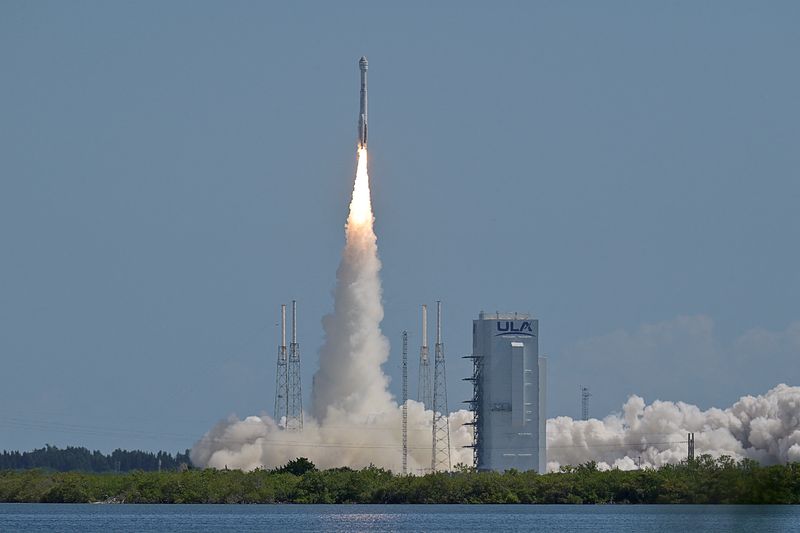By Joey Roulette
WASHINGTON (Reuters) – Problems with Boeing’s Starliner capsule, still docked at the International Space Station (ISS), have upended original plans for the two astronauts to return to Earth, as last-minute fixes and testing yield a mission crucial to the future of Boeing’s space division.
NASA has rescheduled the planned return three times and has now not set a date for it. Since launch on June 5, the capsule has had five helium leaks, five thrusters failed and a propellant valve failed to fully close, causing the space crew and mission managers in Houston to spend more time than expected looking for solutions mid-mission .
Here’s an explanation of possible paths forward for Starliner and its veteran NASA astronauts, Barry “Butch” Wilmore and Sunita “Suni” Williams.
THE CURRENT SITUATION
Starliner can remain docked at the ISS for up to 45 days, according to comments from NASA’s commercial crew manager Steve Stich to reporters. But if it’s absolutely necessary, such as if more problems arise that mission officials can’t resolve in time, it could remain docked for up to 72 days, depending on various backup systems, according to a person familiar with flight planning.
Internally at NASA, Starliner’s latest target return date is July 6, according to this source, who spoke on condition of anonymity. Such a return date would mean that the mission, originally planned for eight days, would instead last a month.
Starliner’s replaceable propulsion system is part of the vessel’s ‘service module’. Current problems center on this system, which is needed to keep the capsule away from the ISS and position it so it can dive through Earth’s atmosphere. Many of Starliner’s thrusters have overheated when fired, and the leakage of helium – used to pressurize the thrusters – appears to be related to how often they are used, Stich said.
Stich said recent test firings of the thrusters while Starliner remains docked gave mission teams confidence in a safe return, although testing and assessments are still ongoing. The mission management team, made up of NASA and Boeing personnel, examines the data on the propulsion problems, runs simulations in Houston and considers how to solve them, such as by updating software or changing the way the hardware is used.
Once NASA officials give the team the green light for a return, Starliner’s thrusters would be used to detach the capsule from the ISS and begin a roughly six-hour journey home, with the orbit gradually tightening before he would dive into the Earth’s atmosphere for a landing. by parachutes and airbags, at one of several possible locations in the southwestern United States.
This is Starliner’s first mission into orbit with astronauts on board – the final test needed before NASA can certify it as the US space agency’s second trip to the ISS. It would join SpaceX’s Crew Dragon, which has dominated government and emerging private markets for human spaceflight amid Starliner’s years-long delays.
WHEN THE UNEXPECTED HAPPENS
Even with the problems with the propulsion system, NASA has said that Starliner would still be able to return the astronauts to Earth if absolutely necessary – that is, if the capsule needs to serve as an escape pod from the ISS in an emergency or if any of Starliner’s perishable items – like the solar panels – are showing signs of expiring ahead of schedule.
Unlike Starliner’s current mission, NASA has not set a scheduled return date for Crew Dragon’s first astronaut mission in 2020. That mission ultimately lasted 62 days because the astronauts needed to help maintain the ISS because the space station was too busy at the time. had few staff. .
IF STARLINER CANNOT BE USED
If Starliner is deemed unable to return Wilmore and Williams safely to Earth, one option would be to send them home aboard Crew Dragon, which in March brought four astronauts to the station and more people in an emergency can transport.
That scenario, considered unlikely, would undoubtedly be embarrassing for Boeing. But NASA and Boeing officials, as well as engineers familiar with the program, told Reuters that nothing about Starliner’s current problems suggests this would be necessary.
In such a scenario, Starliner’s fate would depend on several factors, including the extent of the technical problems.
The last time a NASA astronaut needed an alternate ride home was in 2022, when Russia’s Soyuz capsule suffered a coolant leak after delivering two cosmonauts and U.S. astronaut Frank Rubio to the space station.
NASA had considered Crew Dragon as an alternative ride home for Rubio, but he ended up using an empty Soyuz capsule that Russia had launched as a rescue craft. Rubio’s mission was extended from six months to just over a year – 371 days – a record duration for an American in space.
(Reporting by Joey Roulette; Editing by Will Dunham)
